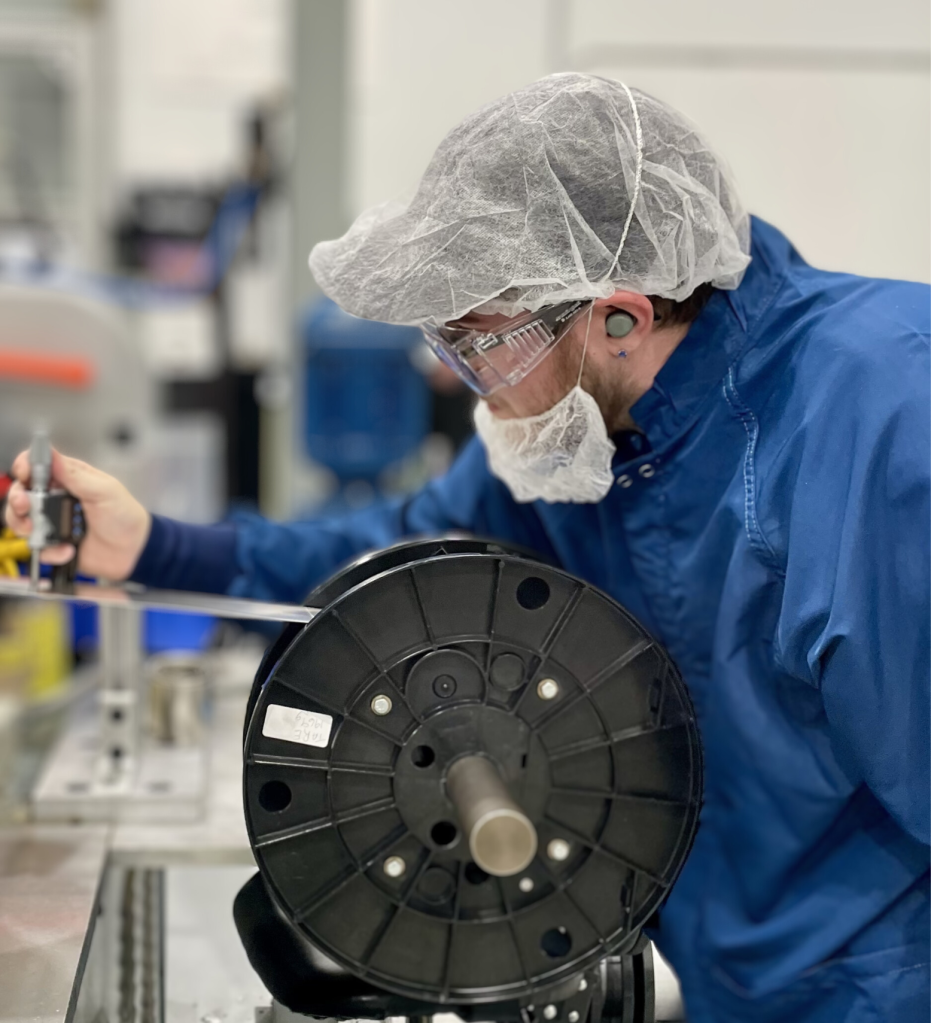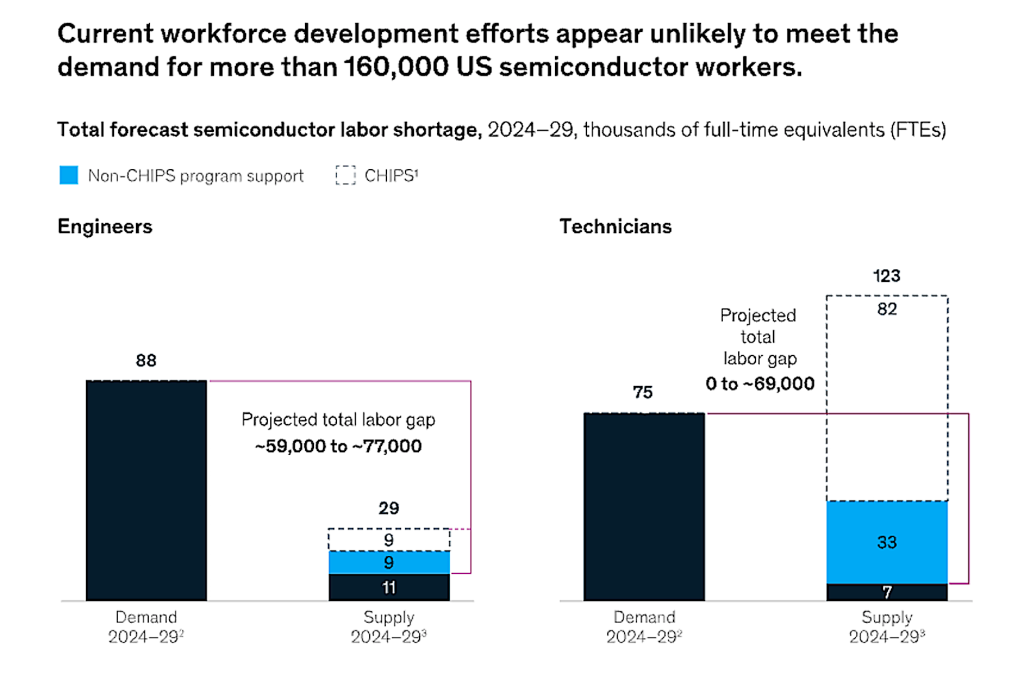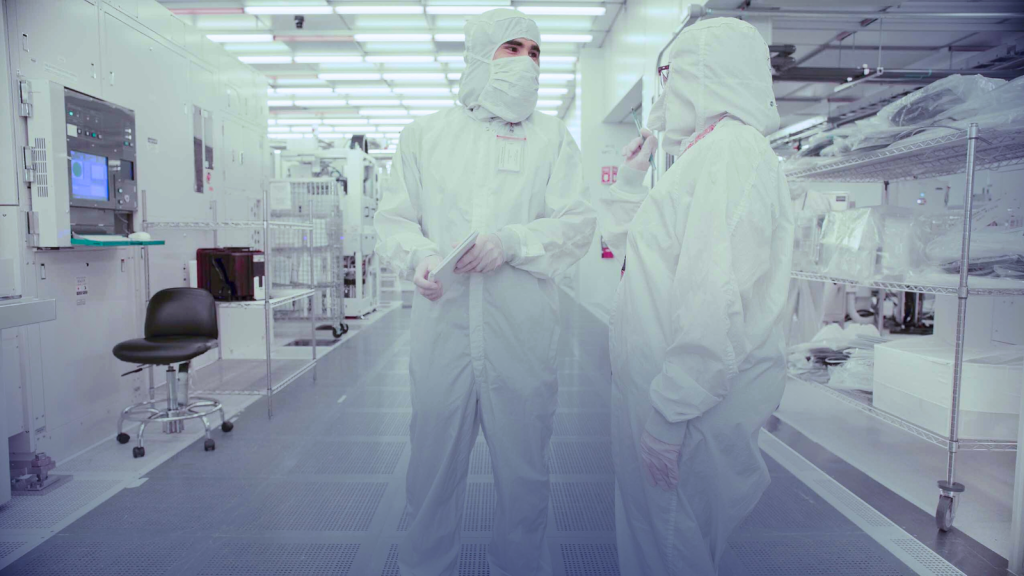Kendall McDaniel felt like a nomad worker, wandering from job to job, never making enough money, never feeling fulfilled. He worked entry-level jobs in construction, in healthcare and at multiple fast-food joints.
In those fast-food jobs, McDaniel said, “You could be bleeding out of your ears and you’d still be expected to come into work.”
With an associate’s degree in theater, McDaniel at the time felt there were no long-term career options ahead for him. Then, two years ago, his cousin — an electrician — told him about a manufacturing company he’d worked at. He liked how they treated him, and that tip convinced McDaniel to apply for another entry-level position; this time, the job led to an apprentice program in the semiconductor industry.
He’s now a machinist at Utica, NY-based Indium, which makes foundational materials for the production of semiconductors and electronics. “I didn’t know anything about the semiconductor industry,” said McDaniel, 29. “I didn’t know anything tech wise. I was never a STEM person. I had mostly been looking at how I could obtain financial stability. That was my main goal coming into this.”
While McDaniel has found the semiconductor manufacturing challenging, it’s allowed him to take on a myriad number of tasks that jibes with his attention deficit disorder and it’s work that feels important.

Kendall McDaniel, an Machinist apprentice at semiconductor materials maker Indium, checks tolerances of rolled metals.
Indium
As a transgender man, McDaniel said he experienced culture shock. In earlier jobs, he said he didn’t feel safe or supported. And moving toward a manufacturing job conjured up images of “a bunch of tough guys.” In fact, most of his co-workers are women, and his managers took both his ADHD and his transgender identity in stride.
“Here, my managers have always encouraged me. If you have time off, go ahead and use it,” he said. “Or, [they’ll say] ‘You’re looking a little tired, do you need anything for the rest of the week?’ My manager always comes over to me and asks me if I’m all set.”
McDaniel is part of a state-sponsored apprenticeship program organized under NY CREATES, an Albany-based, non-profit semiconductor R&D facility, and the National Institute for Industry and Career Advancement (NIICA).
Funneling workers into the industry
One of NIICA’s primary focuses is on building the nation’s talent pipeline in semiconductor and advanced manufacturing industries through scholastic partnerships and certified apprenticeships under a program called Growing Apprenticeships in Nanotechnology and Semiconductors (GAINS), which is funded by the U.S. Department of Labor.
Under GAINS are a number of programs aimed at funneling entry-level workers and others into the semiconductor industry at a time when it’s rapidly expanding in the United States.
The efforts come at a time when the industry doesn’t have anywhere near the workforce — including technicians, computer scientists, and engineers — required to support future needs. By some estimates, the US semiconductor industry faces a worker shortfall of between 59,000 and 146,000 workers by 2029. A minimum of 50,000 trained semiconductor engineers will be needed over the next several years in the US to meet the overwhelming and rapidly growing demand, according to a study by Purdue University.
The broader U.S. economy is set to have a gap of 1.4 million such workers, according to a 2023 study from the Semiconductor Industry Association. So the competition will be fierce over those skilled workers. Compounding the problem is an ongoing exodus of existing talent as virtually all Baby Boomers will be retired by 2030. A study from Deloitte found that nearly 90% of technology leaders interviewed cited recruiting as their biggest challenge.
Incentivized by funding under the CHIPS and Science Act of 2022, semiconductor companies are expected to invest more than $80 billion in opening new or expanding current fabrication plants (fabs) and other related facilities through 2025, according to White House data. For example, after the world’s largest producer of microchips, TSMC, was promised $6.6 billion in CHIPS Act funding last spring, the company announced a third new fab in Arizona.
To date, the CHIPS Act has allocated over $32 billion in proposed funding across 17 companies, 16 states, and 26 projects. However, no CHIPS funding has been disbursed to any companies, according to the US Department of Commerce.
The reshoring of the semiconductor industry is important for the US economy and national security. Semiconductors, the silicon-based processors for everything from dishwashers and smartphones to hypersonic guided missiles, keep US infrastructure, the economy and its military systems running.
But, the United States’ share of global semiconductor manufacturing capacity has been steadily declining for decades, falling from roughly 40% in 1990 to about 12% in 2020, according to the Congressional Research Service (CRS).

McKinsey & Co.
How we got here
Like so many other goods, chip manufacturing is expensive. So, many US semiconductor makers transitioned to a “fabless” model, where they designed the product and offshored manufacturing to East Asia. About 80% of all chip manufacturing takes place in the region, mainly in Taiwan and China, according to The Center for Strategic and International Studies.
The largest tech companies in the US, including Google, Apple, and Amazon, have relied on Taiwan’s TSMC alone for nearly 90% of their chip production.
Then in 2020, the Covid-19 pandemic arrived, exposing an existential threat to the global chip supply. Due to forced lockdowns and remote work, fabs were shuttered and the supply of everything from automobiles to smartphones and computers suffered from the depletion of chip inventories. Add to that the raging US-China trade war, and it became clear reshoring chip production to the US was critical.
In 2022, a report from the US Department of Commerce detailed an “alarming” shortage of computer chips at a time when the median demand for them was as much as 17% higher over a two-year period. “This is a major supply and demand mismatch,” the report said.
The problem with reshoring goes beyond simply building facilities; that’s only a start. The US hasn’t been focused on training engineers and technicians for the semiconductor industry for decades. So, manufacturers have taken on the task themselves, though it’s not likely to be close to meeting staffing needs.
TSMC, for example, is sending employees in the US to Taiwan to learn jobs, according to Taylor Roundtree, associate partner in the semiconductor practice of consulting firm McKinsey & Co. “They’re also bringing some Taiwanese ex-pats in, too,” Roundtree said.
GlobalFoundries, the third-largest chipmaker globally, is casting a wide net to recruit talent. The company has sought out veteran candidates, along with candidates from its own workforce reentry program and an initiative for women in construction.
Micron Technology, Inc., the world’s fourth-largest semiconductor company — and the only U.S. memory and storage manufacturer — plans to invest $100 billion to build the largest semiconductor fabrication facility in the history of the United States in Onondaga County in NY, just two hours from Hudson Valley.
As part of the CHIPS Act, the US Economic Development Administration through its Tech Hubs Program was authorized to receive $10 billion over five years with the main goal of creating additional semiconductor training programs. To date, however, the money isn’t being dispersed as expected.
“If I look at fiscal year 2023, it launched and only had $500 million in funding. So, if I have a five-year program that’s authorized to receive $10 billion, I would have expected $2 billion per year. The first year, it received just a quarter of that,” Roundtree said.
Schools, fabs collaborate on apprenticeships
In response, semiconductor companies have joined with US universities, community colleges and even high schools in states where new fabs are being built or where workers are most needed for existing facilities to create their own joint programs.
“We’ve been working with companies for 10 years,” said Laura Marmolejo, associate dean for the advanced manufacturing programs at Austin Community College (ACC) in Austin, Texas. “Many years ago I worked in the industry. When I went to the faculty side… I basically realized on the non-credit side how much of a disconnect there was between what companies want and what colleges in general want. We’re hung up on, ‘this is credit and this is not credit.'”
“I was part of a corporate training initiative we had back when I worked for a [semiconductor] company. I just saw there was a lot of opportunities for the colleges to do things different, but colleges — education in general — are slow to change,” Marmolejo said.
Ten years ago, ACC began working with Samsung on a grant, which allowed the school to develop a cirriculum, build infrastructure for training, buy equipment, and hire instructors. “At the time, it was me and one other person,” Marmolejo said.
ACC’s semiconductor programs are growing fast. It now has 15 full-time and 30 part-time instructors or staffers. It currently has 300 students enrolled in the program and has trained 2,000, most of whom have remained in the semiconductor industry.
NIICA is currently overseeing 4.900 apprentices working at 79 employers across 17 states. Its focus is on states where fabs and other related facilities are being built or expanded, including Arizona, New York, Texas, Ohio and California.
The greatest demand in the industry today is for engineers and technicians — the people who create the parts for semiconductors and operate and keep the production equipment running, said Clay Nagel, senior director of NIICA’s national center for skills-based learning.
“There’s definitely a dearth of talent,” he said. “Semiconductor manufacturing was moving out of the US for a very long time. Now you’re trying to onshore manufacturing. But there needs to be programs in place to teach people. We need education partners and employers onboard with that.”
That’s where NIICA fits in; the non-profit organization works with K-12 schools, community colleges and universities to help create training programs and apprenticeships with employers.
The apprenticeship programs set the industry apart from others because employees can work full-time jobs and learn skills while getting they’re getting paid.
“There needs to be an awareness campaign,” Nagel said, adding that the number of semiconductor chips needed will roughly triple by 2030. “I wouldn’t call it an emergency yet. I’d call it an urgent issue at this point.”
Data shows that semiconductor industry hiring has been steadily declining for the past two years and job postings are down, a trend Nagel ties to the cyclical nature of the industry. “During the 2021-2022 time frame, you couldn’t make enough computer chips with the shortages and hiring was through roof,” said Nagel, who formerly led technical training at semiconductor maker GlobalFoundries.

McKinsey & Co.
When the economy picks up, people want new cars, televisions and smartphones, which means demand for chips goes up and manufacturers rush to boost inventory. That’s happening now, along with CHIPS Act incentives for semiconductor makers.
“I don’t see it being an issue that hiring is slow now,” said Nagel. “Just in the last 90 days, with companies that received CHIPS Act incentives, we’re now seeing anywhere from 50% hiring increases to 600% increases. They know these fabs are going to go online in late Q4 and through 2025. We predict hiring will continue to accelerate through 2025, 2026. I’d say this is the calm before the storm.
“It’s starting to get gusty,” he said.
ACC is one of the schools NIICA is now collaborating with on training and apprenticeships.
“We have a population that’s unskilled,” Marmolejo said. “There just aren’t a lot of people in the [US] semiconductor industry. Community colleges are really well suited to fill that gap and develop this workforce.
“Five years ago, nobody did apprenticeships,” Marmolejo continued. “Now we have four companies doing apprenticeships this fall. It motivates students to complete their credentials once they’re engaged.”
ACC isn’t trying to compete with the big technical schools such as Texas A&M, Marmolejo said. Community colleges simply don’t have the resources for that. Instead, ACC is focused on entry-level job training in applied technology and manufacturing — skills needed to attain a job as a machine operator or chip assembler.
“There’s a lot of people who need a job first,” Marmolejo said. “I tell students it’s not about starting pay. On average, it’s about $20 an hour, but the growth potential is huge. I have people who come into my program and say, ‘I’ve only gotten a one-dollar a year wage increase in my current job.’ That’s not going to happen in manufacturing. You can see $5 or $6 wage increases by end of year. It’s all performance based.
Dropping out of the funnel
In addition to the lack of semiconductor training programs is another issue: high attrition rates. University students who join engineering programs often change majors before they graduate, the engineers who do graduate often don’t enter engineering jobs — and those who get engineering jobs don’t choose semiconductors.
The state of Oregon, which has tracked semiconductor programs closer than any other state, found that only 8% to 12% of students who graduate from programs go on to work in engineering. “If I look at all undergraduate and graduate degrees awarded, roughly 3.7% of those are what they call core semiconductor degrees,” McKinsey & Co’s Roundtree said. “That’s defined as engineering technician and precision production roles. Of all the courses that people take in the state of Oregon, fewer than 4% are in those core semiconductor roles.
“If we’re facing an engineering shortage, that’s certainly one lever you could pull to get more engineers into the workforce,” Roundtree said. “You lose folks in huge swaths at every step of the funnel.”
More than 60% of executives in a semiconductor industry survey acknowledge it has an image problem in terms of making it an attractive career choice. Semiconductor fabs and development facilities evoke images of workers in white coveralls, filtration masks and cleanrooms where humidity, temperature and pressure conditions must constantly be maintained.
“Folks look at that cleanroom suit, and if I’m trying to choose between stocking shelves at Wal-Mart or putting on a cleanroom suit and moving boxes of wafers around a fab, well, if I’m only getting paid $2 more an hour to move the boxes of wafers around, maybe that’s not something I want to do,” said Bill Wiseman, senior partner and global co-leader of McKinsey & Co’s semiconductors practice.
Said Roundtree: “It’s something that in the US they haven’t had to face for a while, because we’ve not been building a lot of these cutting-edge fabs until now.”
Making the chip industry look cool
In some ways, the semiconductor industry is competing with the Googles and the Metas of the world to attract talent, and those companies can offer remote work — something manufacturing cannot do, said Isaac Hagen, senior vice president of vertical industry development at staffing firm ManpowerGroup.
“The challenging thing these days is making the semiconductor industry look cool,” Hagen said. “The talent largely does not exist. So, there is a need for upskilling, reskilling and what we refer to pre-skilling — so, getting people the skills they need before they even get into the job hunt.”
Most young people simply don’t consider that virtually everything they touch today is powered by a semiconductor chip. “When you start to talk to people about the industry, they realize that it powers the world,” Hagen said.
Peter Bermel, a professor of computer engineering at Purdue University, said one reason students avoid semiconductor engineering degrees is because they have a reputation of being “very hard,” especially in terms of mathematical requirements. “In general, that’s been a huge barrier — to keep people on the path,” Bermel said.
In 2020, Purdue University launched a Department of Defense-funded program called SCALE (Scalable Asymmetric Lifecycle Engagement); its aim is to train up a semiconductor workforce for the defense sector. Seventy-five percent of SCALE graduates remain in the semiconductor field, according to Bermel, who said the program is more attractive than others because it feels more purposeful.
“Since SCALE, things have changed quite a bit,” Bermel said. “We have more students staying in the program. We’ve been tracking our drop-out rate and it’s been about 4%. The students who join SCALE are highly motivated and find a lot of good opportunities to do things that are exciting.”
Cole Lush, a senior undergraduate student at Purdue in SCALE’s aerospace program, currently helps manufacture chips for updating older US ballistic missiles; it’s a job he got after his father, a retired US Air Force lieutenant colonel who worked with defense and data systems, urged him to pursue it.
“For a long time, I wanted to be an astrophysicist because space was my passion,” Lush said, “but then I realized I wanted to work on the systems that go into space. So, I focused more on engineering. Once I got involved with SCALE, I learned more about current events and the opportunities through SCALE.”
As a part of that SCALE, Lush was offered a summer intern program and hired by GRC Integrated Systems, a small consulting firm that works with the US Naval Surface Warfare Centers. During his internship, Lush worked on a project updating the internal electronics in older submarine-launchable ballistic missiles to extend their lifecycle.
“Part of the reason they hired me is because they saw SCALE on my resume at a career fair. Within a month, they told me, ‘you’re in,’” Lush said.
Updating US ballistic missiles is but one of many examples SCALE can offer students through its semiconductor education program. “All the defense systems, and obviously a huge number of commercial systems, are dependent on semiconductors,” Bermel said. “Having students who understand how things work on the inside is vital to preserve and extend these systems and create new and better systems.
NIICA’s Nagel said the bottom line should be that “opportunity is the sexiest part” of the semiconductor field. “A lot of companies are paying off student loans for employees,” Nagel said. “Through tuition reimbursement, you can work your way into engineering or management jobs without college debt.”
Imposter syndrome and the fear of math and sciences
In the past, entry-level positions in the semiconductor industry were rarely noticed by job seekers outside the industry. That changed as would-be workers saw new opportunities for training and advancement.
But new employees who’ve never worked in the semiconductor field can get “imposter syndrome” working in high-tech jobs that often require math and science backgrounds. “I encourage them to not get overwhelmed,” said Joe Rondino, a cleanroom operations manager for NY CREATES. “I tell them to trust the training programs we have and the mentors you’re given. As long as they’re hard workers, opportunities will present themselves. Math isn’t even required for a lot of the jobs.”
Rondino himself had been working in customer service at a large electronics retailer 11 years ago when he decided to change careers and attended a job fair. He was offered an entry-level job as a cleanroom operator working nights at NY CREATES; over time, he moved to a daytime shift and advanced as opportunities arose. He now manages 13 employees, and mentors apprentices.
What’s important is soft skills — the desire and ability to learn, and be a reliable and hard worker, Rondino said.
Hudson Valley Community College (HVCC) in Troy, NY first collaborated with NIICA when chipmaker GlobalFoundries (GF) initiated an Industrial Maintenance Technician Apprenticeship program. To carry out the program, GF conducts on-the-job training of approximately 2,000 hours per year, while the college partners with GF for the required related instruction. The college began conversations with NY CREATES in the spring of 2024 to explore another apprenticeship program partnership within the semiconductor industry
Through a partnership with HVCC, NY CREATES operates an apprenticeship program that lets people get hands-on training while also taking in courses at the college to advance in their careers.
One of Rondino’s apprentices, 27-year-old Kyle Huffer, has been with NY CREATES for eight months. With only a high school diploma, Huffer learned about the semiconductor R&D firm through a relative who also works there.
Huffer was intrigued. “He described it to me, and it sounded very interesting and a lot more mentally stimulating [than] what I was doing before,” said Huffer, who’d been detailing cars at the time.
Huffer works as a clean room operator in a control center, where silicon wafers — thin discs of semiconductor material used to create microchips — are loaded into and out of machines that process them.

Joe Rodino (L), a cleanroom operations manager, mentors Kyle Huffer (R), a cleanroom operator who has worked for NY CREATES the past eight months.
NY CREATES
Huffer loads plastic containers known as Front Opening Unified Pods, or FOUPs, that are filled with wafers and transfers them safely between machines as they’re processed.
“I wouldn’t say it’s challenging, but it’s definitely enjoyable and mentally stimulating,” said Huffer. “This field is booming. Technology is the future. So there’s plenty of room for advancement. We’re only going to get more technologically advanced and what we do contributes to that.”
Lea Montana, another cleanroom operator, runs machinery that processes the silicon wafers. A part of the apprenticeship program, she’s been working at NY CREATES for four years and hopes to become a certified engineering technician.
Montana had been working as a home healthcare aid in her 20s when her stepfather told her about his job at NY CREATES and the scientific aspect of the work interested her. She’s since obtained an associate’s degree in applied science, and is now training another employee on cleanroom work.
“It’s a really exciting job and there’s always something new to learn,” she said. “If you want to continue to learn and grow in a career, this is great. And there are a lot of other job opportunities you can move into on site.”
For Indium’s McDaniel, working in the semiconductor industry has provided something he’d never had before — a stable career. He and his wife recently purchased a house and he was also able to buy a newer car.
McDaniel credits his newfound career with being able to go to school while also working 40 to 50 hours a week, “and I didn’t feel like I was short-changing myself or the family I was starting to build. I’m at a point in my transition that I can pass [for a man] very well; it’s not something I’m concerned about. …The people around me here see me for my work ethic — they don’t just see me.”
HVCC’s apprenticeship program began in late 2021 and had 42 apprentices in the first year. Currently, HVCC has over 70 active apprentices with 20 employed in the semiconductor industry. The college has approximately 500 students in credit-bearing programs to prepare students for jobs in the semiconductor manufacturing workforce.
Needed now: a ‘Top Gun‘ moment
Because a semiconductor fab plant takes anywhere from three to five years to build and get online, and most of the projects didn’t break ground until 2022, the industry won’t see a boom in hiring until late this year through 2026, according to Hagen. But even by then, the workforce needed to staff those facilities will be far from ready.
TSMC, which is spending $40 billion to build a new plant and expand another in Phoenix, earlier this year announced further completion delays. Previously, the company planned for a 2026 opening; it now expects to go online in 2027 or 2028. TSMC makes 90% of the world’s most advanced chips, supplying them to companies like Apple and Nvidia.
Those kinds of delays could, ironically, give the industry a little more breathing room to find and train all of the workers who’ll be needed to staff them. But skills shortages are still likely.
“We kind of need a ‘Top Gun‘ moment,” Wiseman said. “Top Gun came out in 1986, and everybody wanted to become a naval aviator all of a sudden. Before that, most people didn’t even know the Navy had planes, let alone wanting to go join the Navy to fly them. That’s the kind of moment we need in the semiconductor industry.”












